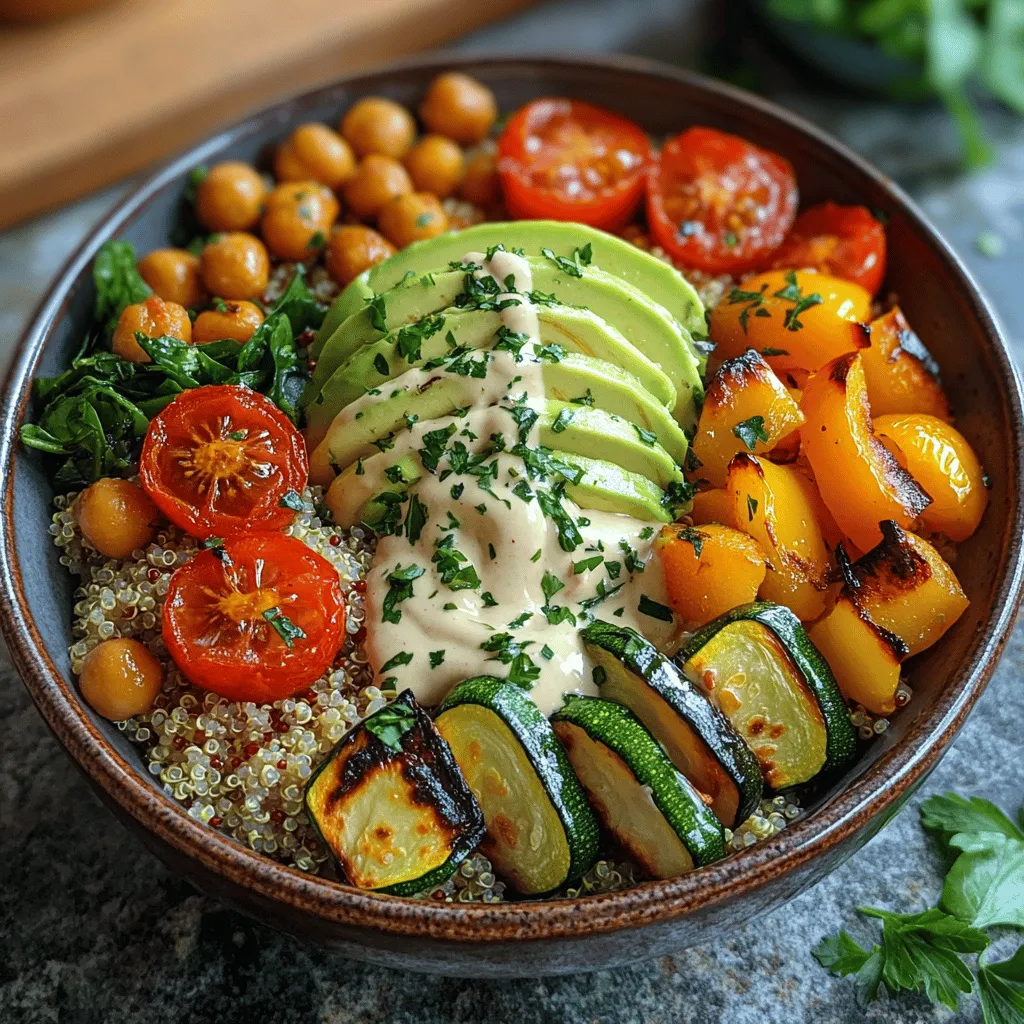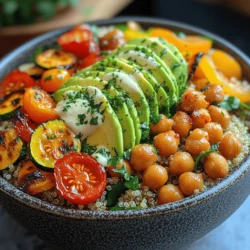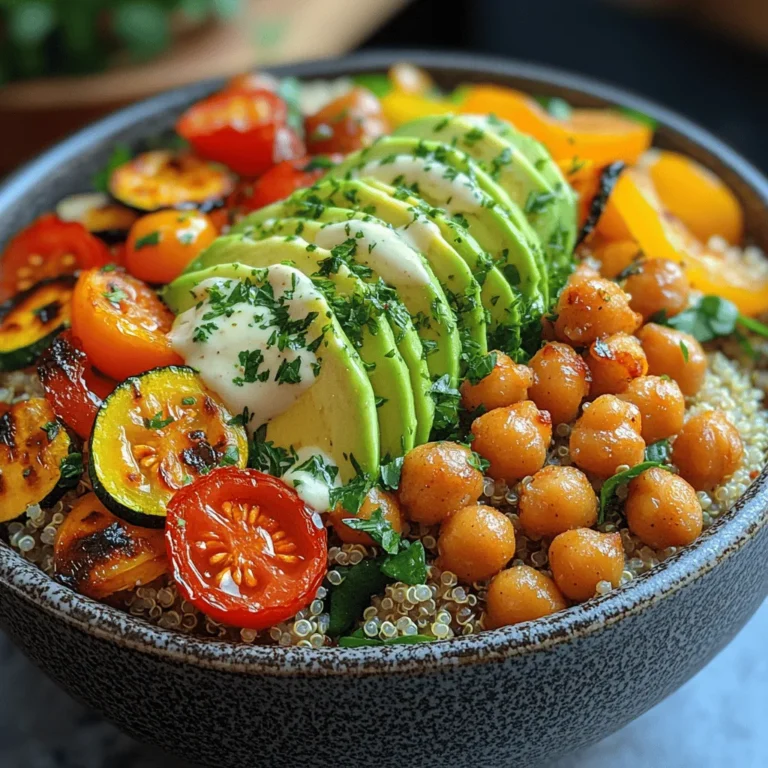Quinoa and Roasted Veggie Power Bowls: A Wholesome Celebration of Flavor and Nutrition
Quinoa and Roasted Veggie Power Bowls are not just a meal; they are a celebration of wholesome ingredients packed with flavor and nutrients. This vibrant dish combines the nutty goodness of quinoa with a colorful array of roasted vegetables, creamy avocado, and protein-rich chickpeas. Perfect for meal prep or a quick weeknight dinner, these power bowls offer a delightful balance of textures and tastes that will satisfy your hunger and nourish your body.
Originally cultivated by the ancient Incas in the Andes Mountains, quinoa has gained popularity around the world as a superfood. Its unique nutritional profile, which includes a complete set of amino acids, makes it an excellent protein source for vegetarians and vegans alike. When paired with roasted vegetables, which bring out the natural sweetness and depth of flavor through caramelization, this dish transforms into a culinary masterpiece that is both satisfying and nutritious.
In this article, we will delve into the recipe for Quinoa and Roasted Veggie Power Bowls, exploring preparation techniques, nutritional benefits, and creative serving suggestions that cater to various dietary preferences. Whether you’re looking to elevate your meal prep routine or simply want to enjoy a wholesome dinner, this recipe is sure to inspire.
Understanding the Ingredients
Exploring Quinoa: The Superfood Grain
Quinoa, often referred to as a “superfood,” is a gluten-free grain that boasts an impressive nutritional profile. A single cup of cooked quinoa provides about 8 grams of protein, making it a fantastic option for those seeking plant-based protein sources. It is also rich in fiber, iron, magnesium, and several essential vitamins and minerals. The health benefits of incorporating quinoa into your diet are extensive, from improved digestion and cardiovascular health to better blood sugar regulation.
For those looking to enhance their meals with quinoa, it serves not only as a base for salads and bowls but also as a substitute for rice or couscous. Its versatility allows it to absorb various flavors, making it an excellent canvas for different seasonings and ingredients.
The Power of Roasted Vegetables
Roasted vegetables bring a rich, caramelized flavor that transforms everyday ingredients into something extraordinary. The benefits of consuming a variety of vegetables are immense; they provide essential vitamins, minerals, and antioxidants that contribute to overall health. Incorporating a rainbow of colors in your dish ensures a wide range of nutrients, which can enhance immune function, support skin health, and reduce the risk of chronic diseases.
When selecting vegetables for roasting, it’s best to choose seasonal produce for the freshest flavor and optimal nutrient content. Some excellent choices for your power bowls include bell peppers, zucchini, sweet potatoes, and Brussels sprouts. The beauty of this dish lies in its adaptability; you can easily switch out vegetables based on what you have on hand or what’s in season.
Chickpeas: A Protein Powerhouse
Chickpeas, or garbanzo beans, are another star ingredient in this power bowl. Known for their high protein and fiber content, they make a perfect addition to vegetarian and vegan meals. A single cup of cooked chickpeas contains around 15 grams of protein and a substantial amount of dietary fiber, which helps promote digestive health and keeps you feeling full longer.
There are various ways to prepare chickpeas, whether you choose to roast them for added crunch, toss them in salads, or incorporate them into soups and stews. For this recipe, roasting chickpeas adds a delightful texture and enhances their nutty flavor, making them an irresistible topping for your quinoa and roasted veggies.
Creamy Avocado and Its Health Benefits
No power bowl is complete without the creamy richness of avocado. This beloved fruit is not only delicious but also packed with healthy monounsaturated fats, which support heart health and provide a satisfying creaminess to the dish. One medium avocado contains around 250 calories, along with nearly 10 grams of fiber, making it a great addition to your diet for boosting satiety and nutrient intake.
In addition to power bowls, avocados can be easily integrated into other meals, such as smoothies, salads, and sandwiches. Their versatility and creamy texture make them a staple in many healthy eating plans.
Preparation Techniques
Perfectly Cooking Quinoa
To achieve the best results when cooking quinoa, it’s essential to rinse it thoroughly before cooking. This step removes the natural coating called saponin, which can impart a bitter flavor. Here’s a step-by-step guide to rinsing and cooking quinoa:
1. Rinse: Place one cup of quinoa in a fine-mesh strainer and rinse under cold running water for about 30 seconds. Use your hands to agitate the grains and ensure that all of the quinoa is rinsed.
2. Measure Water: For every cup of rinsed quinoa, use two cups of water or vegetable broth for added flavor.
3. Boil: In a medium saucepan, bring the water or broth to a rolling boil.
4. Cook: Add the rinsed quinoa to the boiling liquid, reduce the heat to low, and cover the pot. Allow it to simmer for 15 minutes or until all the liquid is absorbed.
5. Fluff: Remove the pot from heat and let it sit, covered, for another 5 minutes. Fluff the quinoa with a fork before serving to achieve a light and airy texture.
Tips for Achieving Fluffy Quinoa:
– Use a 2:1 water-to-quinoa ratio for best results.
– Avoid overcooking; once the water is absorbed, remove it from heat immediately.
Roasting Vegetables to Perfection
Roasting vegetables is an art that can elevate the flavor profile of your power bowls significantly. Here are some best practices to ensure perfectly roasted vegetables:
1. Preheat the Oven: Begin by preheating your oven to 425°F (220°C). A hot oven is essential for achieving that desirable caramelization.
2. Cut Evenly: Chop your vegetables into uniform pieces to ensure even cooking. This will help all the pieces roast at the same rate.
3. Toss with Oil and Seasoning: In a large bowl, toss the vegetable pieces with olive oil, salt, pepper, and any additional seasonings or herbs you prefer. Garlic powder, paprika, and rosemary make excellent choices.
4. Spread in a Single Layer: Arrange the vegetables on a baking sheet in a single layer. Overcrowding can lead to steaming instead of roasting, so use multiple sheets if necessary.
5. Roast: Bake for 20-30 minutes, flipping the vegetables halfway through, until they are tender and golden brown.
Enhancing Flavors with Seasonings and Spices:
– Experiment with different herbs like thyme or oregano for added depth.
– A drizzle of balsamic vinegar or lemon juice after roasting can brighten the flavors.
Mastering Chickpea Preparation
Chickpeas can be prepared in various ways, but for this recipe, roasting them will provide a satisfying crunch and enhance their flavor. Here’s how to prepare chickpeas for your power bowls:
1. Using Canned vs. Dried Chickpeas: If you’re short on time, canned chickpeas are a convenient option. Simply drain and rinse them before roasting. For dried chickpeas, soak them overnight and boil until tender.
2. Roasting Chickpeas: To roast chickpeas, follow these simple steps:
– Preheat your oven to 400°F (200°C).
– Drain and rinse canned chickpeas or boil soaked dried chickpeas until tender, then drain.
– Pat them dry with a kitchen towel to remove excess moisture.
– Toss with olive oil, salt, and spices of your choice (cumin and paprika work well).
– Spread them out on a baking sheet in a single layer and roast for about 20-30 minutes, shaking the pan occasionally until they are golden brown and crispy.
By mastering these preparation techniques, you will set the stage for creating delicious, nutritious Quinoa and Roasted Veggie Power Bowls that are sure to impress both your palate and your guests. In the next part of this article, we will explore how to assemble these beautiful bowls, starting with the quinoa base. Stay tuned for tips on creative variations and serving suggestions that will elevate your meal experience even further.

How to Properly Layer Quinoa in Your Bowl
Layering is crucial when assembling your quinoa and roasted veggie power bowls. Start by placing a generous scoop of cooked quinoa at the bottom of your bowl. This acts as a hearty base, providing a nutritious foundation.
To ensure even distribution of flavors, consider fluffing the quinoa with a fork before adding it to your bowl. This technique separates the grains, preventing clumping and allowing for better absorption of the flavors from the veggies and dressing.
Remember, the quinoa can be flavored in numerous ways, allowing you to change the profile of your dish with ease.
Variations for Flavoring the Quinoa
Flavoring your quinoa can elevate the taste of your power bowl significantly. Here are some creative ideas to infuse your quinoa with extra flavor:
1. Herbal Infusion: Cook quinoa in vegetable broth instead of water and add fresh herbs like thyme or rosemary for an aromatic touch.
2. Citrus Zest: Incorporate lemon or lime zest into the cooking water to impart a refreshing citrus flavor.
3. Spice it Up: Stir in spices such as cumin, paprika, or turmeric while the quinoa cooks for an earthy taste. This will not only enhance the flavor but also add a vibrant color to your dish.
4. Garlic and Onion: Sauté minced garlic and onion in a little olive oil before adding the quinoa and liquid. This will create a savory base that complements the roasted vegetables beautifully.
Building Layers of Flavor with Roasted Veggies
Ideas for Mixing and Matching Vegetables
Roasted vegetables are the heart of these power bowls. The beauty of this recipe lies in its versatility; you can use a variety of seasonal vegetables. Here are some excellent options to consider:
– Root Vegetables: Carrots, sweet potatoes, and beets offer sweetness and earthiness when roasted.
– Cruciferous Veggies: Broccoli, cauliflower, and Brussels sprouts become crispy and delicious with roasting.
– Bell Peppers and Zucchini: These add color and a slightly sweet flavor, making them perfect for breaking the monotony of textures.
– Onions and Garlic: Roasted onions add sweetness, while garlic imparts a rich depth to your dish.
The Importance of Color and Texture in Your Bowl
A well-constructed power bowl should be visually appealing and texturally interesting. Aim for a balance of colors; vibrant greens, bright yellows, and deep purples not only make your dish more attractive but also indicate a variety of nutrients.
Incorporating different textures is equally important—crispy roasted veggies contrast beautifully with the fluffy quinoa and creamy avocado, creating a satisfying mouthfeel.
Incorporating Fresh Greens
Benefits of Adding Spinach or Kale
Adding leafy greens like spinach or kale to your power bowl not only boosts its nutritional value but also adds freshness. Spinach is rich in iron and vitamins A, C, and K, while kale provides antioxidants and fiber.
These greens are low in calories yet high in nutrients, making them an ideal addition to any meal. Moreover, they add a delightful crunch and vibrant color to your bowl.
Creative Ways to Include Greens in Your Power Bowl
– Raw or Lightly Sautéed: Toss fresh spinach or kale in a little olive oil and lemon juice before adding them to your bowl for enhanced flavor.
– Incorporate a Salad Base: Start with a bed of greens and then layer your quinoa and roasted veggies on top for a refreshing twist.
– Blend into Dressings: For those who might be hesitant about eating greens, consider blending spinach into your dressing for a nutrient boost without overwhelming flavors.
Adding Creaminess with Avocado
Best Practices for Slicing and Serving Avocado
Avocado adds a creamy texture and healthy fats to your power bowl, enhancing its overall flavor profile. To slice an avocado perfectly, follow these steps:
1. Cut Around the Pit: Use a sharp knife to slice the avocado in half, rotating around the pit.
2. Twist to Separate: Gently twist the two halves to separate them.
3. Remove the Pit: Carefully strike the pit with the knife and twist to remove it.
4. Slice and Scoop: Cut the avocado flesh into slices while still in the skin, then use a spoon to scoop out the pieces.
Alternative Toppings for Creaminess
If you don’t have avocado on hand, consider these alternatives for a creamy element:
– Hummus: This chickpea spread is rich and creamy, making it a great substitute.
– Greek Yogurt: A dollop of Greek yogurt adds creaminess and a protein boost.
– Nut Butters: A spoonful of almond or cashew butter can lend a unique flavor while adding healthy fats.
Dressing and Garnishing Your Bowls
Choosing the Right Dressing
The right dressing can take your quinoa and roasted veggie power bowl to the next level. Tahini-based dressings are popular for their nutty flavor and creamy texture. To make a simple tahini dressing, whisk together:
– 2 tablespoons tahini
– 1 tablespoon lemon juice
– 1 tablespoon water (more for desired consistency)
– 1 clove garlic, minced
– Salt and pepper to taste
Other dressing options include balsamic vinaigrette, yogurt-based dressings, or even a simple olive oil and vinegar mix.
How to Make Your Own Dressings for Added Freshness
Homemade dressings are not only healthier but also allow you to customize flavors. Here are a couple of easy recipes:
1. Lemon-Garlic Dressing:
– ¼ cup olive oil
– 2 tablespoons lemon juice
– 1 garlic clove, minced
– Salt and pepper to taste
– Whisk together and drizzle over your bowl just before serving.
2. Creamy Avocado Dressing:
– 1 ripe avocado
– 1 tablespoon lime juice
– 1 tablespoon water (adjust for desired consistency)
– Salt to taste
– Blend until smooth and creamy, then pour over the bowl.
Garnishing for Visual Appeal and Flavor
Garnishing your power bowl adds not only visual appeal but also layers of flavor. Fresh herbs like cilantro, parsley, or basil can brighten up the dish and provide a fresh taste.
Other garnishing ideas include:
– Toasted Nuts or Seeds: Sprinkle some sesame seeds, pumpkin seeds, or chopped nuts on top for added crunch.
– Microgreens: These tiny greens pack a flavor punch and are visually striking.
– Chili Flakes or Hot Sauce: For those who enjoy a kick, a sprinkle of chili flakes or a drizzle of hot sauce can elevate the heat level.
Nutritional Benefits of Quinoa and Roasted Veggie Power Bowls
Analyzing the Nutritional Components
Quinoa and roasted veggie power bowls are a nutritional powerhouse. Each ingredient contributes essential nutrients:
– Quinoa: A complete protein that contains all nine essential amino acids, making it an excellent plant-based protein source. It is also high in fiber and magnesium.
– Vegetables: Roasted veggies provide a range of vitamins (A, C, K) and minerals, along with antioxidants that combat inflammation and promote overall health.
– Greens: Spinach and kale are nutrient-dense, offering iron, calcium, and vitamins while adding very few calories.
– Avocado: Packed with healthy fats, fiber, and potassium, avocados contribute to heart health and satiety.
How This Meal Supports a Balanced Diet
Power bowls are easy to customize, making them an excellent choice for anyone seeking a balanced diet. By incorporating a variety of food groups—grains, proteins, healthy fats, and plenty of vegetables—you ensure you’re getting a well-rounded meal that satisfies both hunger and nutritional needs.
Benefits of Plant-Based Eating
Overview of the Advantages of Plant-Based Meals
Embracing plant-based meals like quinoa and roasted veggie power bowls can lead to numerous health benefits. Studies show that plant-based diets are associated with lower risks of chronic diseases, including heart disease, diabetes, and certain cancers.
These diets are generally lower in calories and saturated fats while being higher in fiber, promoting better digestion and weight management.
How Power Bowls Fit into a Healthy Lifestyle
Power bowls epitomize the principles of plant-based eating—rich in nutrients, low in unhealthy fats, and customizable to fit various dietary needs. They can easily be made vegan, gluten-free, or adjusted for specific dietary preferences, making them suitable for nearly everyone.
Incorporating quinoa and roasted veggie power bowls into your weekly meal planning not only diversifies your diet but also encourages healthier eating habits.
Conclusion
Quinoa and roasted veggie power bowls are not only delicious but also a powerhouse of nutrition, making them an excellent choice for any meal. This recipe encourages creativity in the kitchen, allowing you to customize each bowl to suit your taste preferences while maintaining a focus on health.
By understanding the benefits of the ingredients and the preparation techniques involved, you can create a satisfying dish that nourishes both body and soul. Enjoy the vibrant flavors and health benefits of these power bowls as a staple in your meal planning!


